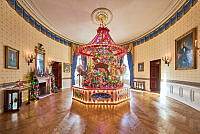Rubenstein Center Scholarship
At Work in the Lincoln White House
A Newly Republished Book Reveals Key Details About African American Staff Members in Lincoln's Era

They Knew Lincoln features recollections of Lincoln from the African Americans who knew him most closely.
William Johnson accompanied Abraham Lincoln on the journey from Illinois to Washington, where Lincoln would take the helm of a nation engulfed in crisis. Lincoln hoped Johnson, who was African American, would work as his personal attendant in the White House, but the existing staff had other ideas. They refused to work with Johnson, an outsider with a particularly dark complexion. Johnson was given a temporary position tending the furnace, and after several months, Lincoln managed to secure a position for him as a laborer in the Treasury Department. This constituted evidence, the historian John E. Washington believed, that Lincoln was a kind-hearted and fair employer.
Washington’s 1942 book, They Knew Lincoln, is an invaluable resource for historians of the White House and its residents. For the Lincoln years, few written records exist to tell us about the people, black and white, who worked in the White House and their interactions with the first family. Information about African Americans is particularly sparse, and no single source is more important than They Knew Lincoln, out of print for more than 75 years but recently republished.

Elizabeth Keckly
Born in 1880, John E. Washington had a lifelong interest in the history of the Civil War period. He grew up near Ford’s Theatre, listening to stories told by his grandmother’s friends, many of whom had been born into slavery and escaped bondage during the war. Washington intensified his research on Lincoln and African Americans in 1935, amid public claims that Elizabeth Keckly, the dressmaker and confidante to Mary Lincoln, had never existed.1
Washington’s intent was to recount and preserve the stories of people like Keckly and Johnson—black men and women who had known the Lincolns but whose lives were in danger of being lost to history. He drew on every method available—interviews, archival research, his own memories, and old newspapers—to discover the history of African American White House employees during the Lincoln administration. In some cases all he had were people’s recollections of the distant past. He knew that people’s memories could be fallible, and so wherever he could, he supplemented oral accounts with written documents.
Washington recalled the stories of several of his grandmother’s friends who had known or encountered the Lincolns. Rosetta Wells did plain sewing in the White House and remembered that Mrs. Lincoln “had her ways,” but that “her bark was worse than her bite.” Mary Dines taught school and directed the choir at a military-run camp for escaping slaves in the capital. Lincoln visited the camp multiple times, she recalled, and was touched by the singing and preaching he heard there.

President Abraham Lincoln
Then as now, the capital was a status-conscious city in which people readily used personal connections to get ahead. This was true of politicians and lobbyists, and it was also true of African Americans with connections to the city’s white elite. Washington explained that the black people who worked in the White House “were considered the cream of Washington’s colored society and were the recognized leaders in church, fraternal and social organizations.”
White House messenger William Slade and his wife Josephine, who sewed for the Lincolns, were active in the city’s most prestigious African-American church, 15th Street Presbyterian, as was Elizabeth Keckly. During the war, all three were leaders in the effort to raise money to aid enslaved people who were migrating into the capital in search of freedom. William Slade was a published poet and a political activist. He was president of a civil rights organization called the Social, Civil, and Statistical Association, and in 1863 he pressed Lincoln on whom to appoint as officers of the regiment of black soldiers being recruited in Washington. The following year he added his name to a voting rights petition. Josephine Slade distinguished herself for her aid to freedpeople, which she continued even amid outbreaks of disease. After the war, she joined the movement for women’s voting rights in the nation’s capital.2
Men and women lucky enough to secure employment in the White House often helped family members get hired. In that respect, William and Josephine Slade were not unusual. Mary Lincoln sometimes engaged Rosetta Wells’ husband, who owned a team of horses, for rides to the train station. And Peter Brown, a butler and waiter, helped his son Robert secure a job in the kitchen and pantry. Robert’s connections to powerful people served him well, for on recommendation of Ulysses S. Grant, he was later hired as a coachman to President James Garfield.
White House employment came with perks that were worth guarding, and according to Washington, the White House staff could be “clannish” and “jealous,” particularly when administrations changed over. Members of the staff worried about their job security at such times, as a new president might bring his own household employees to work in the White House. Such concerns helped explain the staff’s rejection of William Johnson of Illinois.

The South Lawn of the White House during the Lincoln administration.
Service work for prominent men in government could be prestigious, but it was also taxing. Many employers made little distinction between the regular work day and private “service” at their homes, and they insisted that employees staff parties or other evening events after a full day on the job. As Washington put it, “Most of the colored men then in Government services as laborers and messengers depended on outside work to help them in supporting their families. Nearly everyone not only did the work required by the Government, but also served as house servants and valets for their chief without extra compensation. They served him faithfully at his home, before Government time, and often into the night at dinners and receptions.”
Washington was appalled when he read claims in the Washington Star that a white woman journalist had written Elizabeth Keckly’s 1868 memoir, Behind the Scenes, and that Keckly herself had never even existed. He sent a letter to the editor, insisting that those who doubted Keckly’s existence could “easily obtain all facts” about her “from persons who knew her best.” From there embarked his own project on what he called “the colored side of Lincolniana.”
As Washington well understood, the White House was a complex workplace, and the people who toiled there—those who cooked the meals, sewed the clothes, and kept the furnaces running—led interesting lives that are worth remembering. They did much more than brush shoulders with the Lincolns. They cared for their families, they contributed to their communities, and they should be remembered as part of the fabric of American history.







































